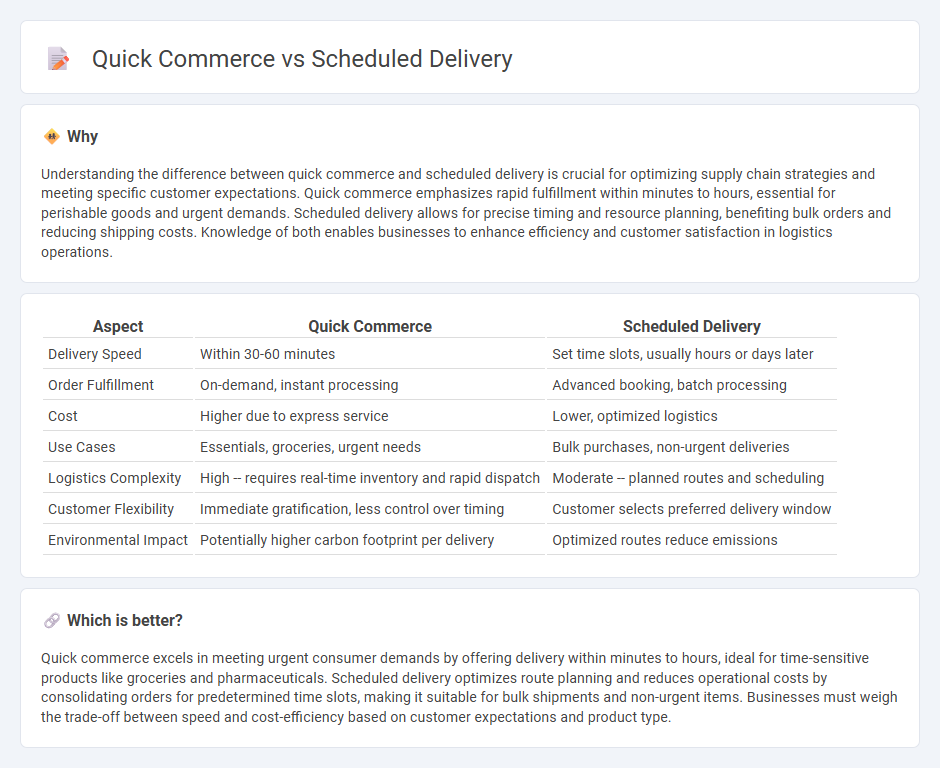
Quick commerce focuses on ultra-fast delivery, often within minutes or hours, catering to urgent consumer needs in urban areas. Scheduled delivery offers pre-arranged time slots for shipments, allowing for predictable logistics and improved resource planning. Explore more to understand which delivery method best suits your business strategy.
Why it is important
Understanding the difference between quick commerce and scheduled delivery is crucial for optimizing supply chain strategies and meeting specific customer expectations. Quick commerce emphasizes rapid fulfillment within minutes to hours, essential for perishable goods and urgent demands. Scheduled delivery allows for precise timing and resource planning, benefiting bulk orders and reducing shipping costs. Knowledge of both enables businesses to enhance efficiency and customer satisfaction in logistics operations.
Comparison Table
| Aspect | Quick Commerce | Scheduled Delivery |
|---|---|---|
| Delivery Speed | Within 30-60 minutes | Set time slots, usually hours or days later |
| Order Fulfillment | On-demand, instant processing | Advanced booking, batch processing |
| Cost | Higher due to express service | Lower, optimized logistics |
| Use Cases | Essentials, groceries, urgent needs | Bulk purchases, non-urgent deliveries |
| Logistics Complexity | High -- requires real-time inventory and rapid dispatch | Moderate -- planned routes and scheduling |
| Customer Flexibility | Immediate gratification, less control over timing | Customer selects preferred delivery window |
| Environmental Impact | Potentially higher carbon footprint per delivery | Optimized routes reduce emissions |
Which is better?
Quick commerce excels in meeting urgent consumer demands by offering delivery within minutes to hours, ideal for time-sensitive products like groceries and pharmaceuticals. Scheduled delivery optimizes route planning and reduces operational costs by consolidating orders for predetermined time slots, making it suitable for bulk shipments and non-urgent items. Businesses must weigh the trade-off between speed and cost-efficiency based on customer expectations and product type.
Connection
Quick commerce and scheduled delivery are connected through their shared focus on enhancing customer convenience and operational efficiency in logistics. Quick commerce relies on rapid fulfillment processes that often integrate scheduled delivery slots to optimize route planning and resource allocation. This synergy reduces delivery times while maintaining service predictability, crucial for meeting rising consumer expectations in on-demand logistics.
Key Terms
Lead Time
Scheduled delivery offers predictable lead times ranging from hours to days, optimizing customer convenience for non-urgent purchases. Quick commerce reduces lead times dramatically to under an hour, catering to immediate consumer needs with hyper-local inventory and on-demand logistics. Explore how lead time impacts customer satisfaction and operational efficiency in both delivery models.
Order Fulfillment
Scheduled delivery optimizes order fulfillment by allowing precise time slots, reducing delivery errors and improving customer satisfaction through predictable service. Quick commerce prioritizes speed, leveraging real-time inventory and local micro-fulfillment centers to meet immediate consumer demands within minutes. Explore more about how these strategies impact logistics efficiency and customer experience.
Last Mile Delivery
Scheduled delivery offers precise time windows for customers, enhancing predictability and convenience in last mile delivery. Quick commerce prioritizes speed, often delivering within minutes to meet instant demand but requires efficient logistics and localized warehouses. Explore how businesses balance speed and reliability to optimize last mile delivery strategies.
Source and External Links
What is Scheduled Delivery? Why is it Important? - FarEye - Scheduled delivery is a service where customers choose a specific date and time slot for their shipment, allowing for convenience, flexibility, and security by ensuring someone is available to receive the item and reducing missed deliveries and theft risks.
What is Scheduled Delivery, and How Does it Work? - Speedsternow - Scheduled delivery allows customers to select exact delivery dates and times, offering precise, customized delivery compared to traditional broad time windows, enhancing customer satisfaction and brand loyalty through efficiency and reliability.
Scheduled Delivery Service - Dropoff - This service guarantees packages arrive at a specified day and time, providing features like real-time tracking, 24/7 customer service, nationwide coverage, and flexible scheduling through an easy-to-use platform designed to support businesses' timely delivery needs.
 dowidth.com
dowidth.com